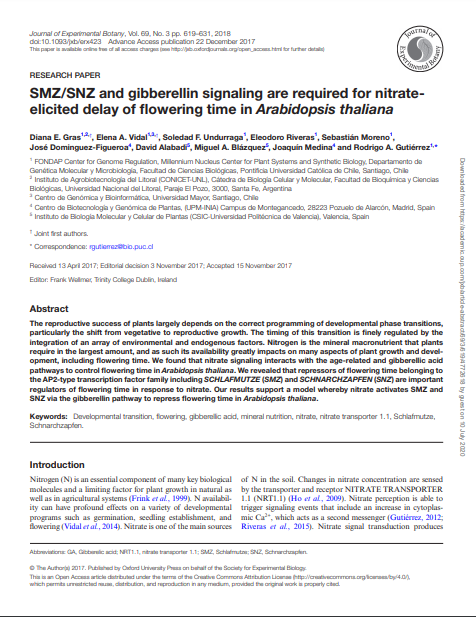SMZ/SNZ and gibberellin signaling are required for nitrate-elicited delay of flowering time in Arabidopsis thaliana

Fecha
2018Autor
Vidal, Elena A. [Univ Mayor, Fac Ciencias, Ctr Genom & Bioinformat, Santiago, Chile]
Gras, Diana E.
Undurraga, Soledad F.
Riveras, Eleodoro
Moreno, Sebastián
Domínguez-Figueroa, José
Alabadi, David
Blazquez, Miguel A.
Medina, Joaquín
Gutiérrez, Rodrigo A.
Ubicación geográfica
Notas
HERRAMIENTAS
Acceda a títulos restringidos
¿Cómo descargar?Resumen
The reproductive success of plants largely depends on the correct programming of developmental phase transitions, particularly the shift from vegetative to reproductive growth. The timing of this transition is finely regulated by the integration of an array of environmental and endogenous factors. Nitrogen is the mineral macronutrient that plants require in the largest amount, and as such its availability greatly impacts on many aspects of plant growth and development, including flowering time. We found that nitrate signaling interacts with the age-related and gibberellic acid pathways to control flowering time in Arabidopsis thaliana. We revealed that repressors of flowering time belonging to the AP2-type transcription factor family including SCHLAFMUTZE (SMZ) and SCHNARCHZAPFEN (SNZ) are important regulators of flowering time in response to nitrate. Our results support a model whereby nitrate activates SMZ and SNZ via the gibberellin pathway to repress flowering time in Arabidopsis thaliana.
Coleccion/es a la/s que pertenece:
Si usted es autor(a) de este documento y NO desea que su publicación tenga acceso público en este repositorio, por favor complete el formulario aquí.